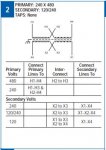Jerramundi
Senior Member
- Location
- Chicago
- Occupation
- Licensed Residential Electrician
Stuck in a semantic argument w/ myself and require a little bit of clarification...
I'm trying to discern whether or not the following transformer would qualify as a "single voltage, two wire secondary" (see diagram below).
Clearly there are four wires coming off the secondary and the option to wire the secondary for multiple voltages (120V and/or 240V).
I should probably just stop here and acknowledge that this is NOT a "single voltage, two wire secondary," but in an attempt to justify possibly avoiding secondary overcurrent protection and save on cost, my brain does the following...
Per the wiring diagram below, I will be wiring X1 to X3 and X2 to X4 to produce the single voltage of 120V. Leaving the transformer enclosure will be only two wires and a single voltage, which makes me think I could make the argument that these conductors ARE a "single voltage, two wire secondary."
Then I loop back around mentally and remind myself to be honest about the fact that there are actually four wires coming off the secondary and multiple voltages available, even if I am ultimately creating a "single voltage, two wire secondary."
Which is it? Is my initial notion correct about this not being a "single voltage, two wire secondary" or do my semantic games fly? haha.

I'm trying to discern whether or not the following transformer would qualify as a "single voltage, two wire secondary" (see diagram below).
Clearly there are four wires coming off the secondary and the option to wire the secondary for multiple voltages (120V and/or 240V).
I should probably just stop here and acknowledge that this is NOT a "single voltage, two wire secondary," but in an attempt to justify possibly avoiding secondary overcurrent protection and save on cost, my brain does the following...
Per the wiring diagram below, I will be wiring X1 to X3 and X2 to X4 to produce the single voltage of 120V. Leaving the transformer enclosure will be only two wires and a single voltage, which makes me think I could make the argument that these conductors ARE a "single voltage, two wire secondary."
Then I loop back around mentally and remind myself to be honest about the fact that there are actually four wires coming off the secondary and multiple voltages available, even if I am ultimately creating a "single voltage, two wire secondary."
Which is it? Is my initial notion correct about this not being a "single voltage, two wire secondary" or do my semantic games fly? haha.


